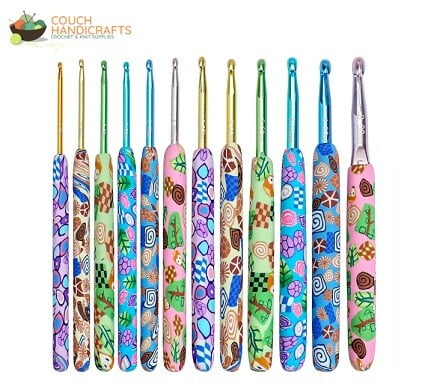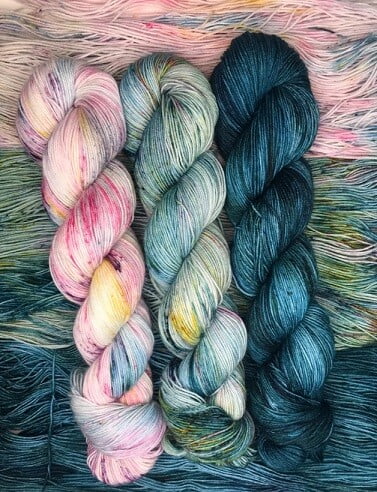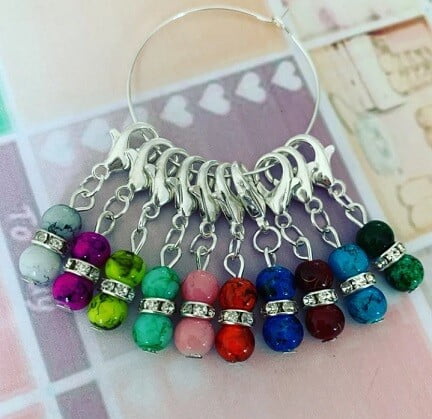These crochet tips and techniques are ones I’ve picked up over the years.
I felt inspired to write them down as a result of questions from a craft group I lead as a volunteer:
“Do you have any crochet tips for beginners?”
“What crochet hints and tips do you wish someone had told you when you started crocheting?”

Jera’s Jamboree receives payments for affiliate advertising. This is at no extra cost to you. As an Amazon Associate I earn from qualifying purchases. As a Cratejoy affiliate I earn if you click on a link and shop from my link. Please see my disclosure policy for more information.
If you’re a crochet beginner, I hope you’ll find something new to try and the tips help.
If you’ve been crocheting for a while, you might find there are crochet tips you haven’t heard before.
Do you have tips I haven’t mentioned? You’re welcome to leave your own tips in the comments.
I’ve sorted the crochet tips and tricks into sections:
- Costs
- Crochet Hooks
- Yarn
- Yarn Needles
- Crochet Patterns
- Crochet Projects
- Storing your current project
- Crochet Techniques
- How to use Stitch Markers/Progress Keepers
- Amigurumi tips
- Finishing Off
- Neck, shoulder and arm health
- Motivation

Crochet Hacks and Tips
Costs
Budgeting for your crochet purchases will help you keep on top of your overall finances! Use a budget sheet to work out your crochet costs and record your savings. Download your free printable crochet budget planner.
The most expensive is not necessarily the best. ALWAYS read reviews to help you make an informed choice.
Crochet Hooks
Choosing a hook is personal. Try a variety of hooks and experiment with aluminium, plastic, wood and bamboo. Experimenting with different crochet hooks will help you find the brand that is right for you.
If you consistently drop loops, it might be worth trying a more tapered throat.
Selecting one hook and sticking with it for the same project should help with tension. Don’t ever change your hook partway through your project.
It doesn’t matter how you hold your hook. There is no right or wrong way. You will need to hold it the same throughout the project to maintain tension.
Yarn
Only try and buy yarn for set projects (otherwise you’ll end up buying reduced yarn and have a massive stash – I speak from experience :))
If you are going to substitute the yarn, ALWAYS check the number of metres of yarn in the balls recommended for a pattern. Yarns that have the same number of grams have different lengths.
Buy your yarn by length and not grams.
Buy one more ball than you think you need for a project to make sure you have the same dye lots should you run out.
Use metal snap hairclips on the ends of used balls of yarn to keep them from unravelling.
Save a ball band from each of your projects to use for reference for future crochet projects.
If you forget to save the ball band (like me!) you can still work out the weight of the yarn in your stash by using Wraps Per Inch (WPI). Using a 1″ ruler or gauge, wrap the yarn until it fills the inch and count how many wraps fit. Do this a couple of times, divide by 2 and you’ll have an average.
Then use the chart below to work out the weight of your yarn.

I’ve found the best way to wind hand-dyed skeins without a yarn winder is to untwist the skein and place around my neck and knees while using my hands to wind into a ball.
I start with wrapping the yarn around my three middle fingers x 10 and then remove my fingers, changing direction. Once the ball gets bigger, I increase the number of times I wind. If you find this difficult, try using a dining chair (instead of your neck and knees).
Yarn winders can be inexpensive – if you use hand-dyed skeins a lot it could be worth investing in one.
Yarn Needles
If you have a needle with a small eye, use a needle threader.
Crochet Patterns
Always read through a crochet pattern or watch the video all the way through before you start crocheting.
If tension or gauge is important to your project, always crochet a swatch before you begin and compare it to the tension/gauge of the pattern.
Completing a swatch won’t be wasted. Save them and join together to make a blanket!
When you come across a new crochet stitch, search in your browser and watch the tutorials. Then write them down and save to your device/print for your file. Finally, practice the stitch by making a swatch before you start your project.
If you are a visual learner, look for patterns that offer colour-coded diagrams and charts.

Keep a cheat sheet of crochet symbols close by to refer to. Download your free crochet symbol printable.
Have a cheat sheet of crochet abbreviations handy so that you can find the information you need at a glance. Download your free crochet abbreviations printable and keep it with your pattern.
Slowing down crochet videos on YouTube will help you to crochet along with the instructions. Click on settings (the wheel highlighted in red on the image below) and then click on playback speed to choose a slower setting. You can also speed up the video.

You’ll find 10 more helpful tips for beginners in the crochet gnome patterns.
Crochet Projects
Limit the number of projects you have on the go and make a plan for what you want to crochet next. Use a crochet journal to keep you on track.
Always make a note of what hook size you are using on which project. If you have to leave it for whatever reason, when you go back to it days/weeks later, you’ve probably forgotten which hook you were using!
Alternatively consider using the ‘queue’ feature on Ravelry (you need to be registered) or an app such as Pocket Crochet (Google or Apple).
To get to your Ravelry Queue, click on my notebook and then Queue (highlighted in yellow on the image below).

Storing your current project
When you’ve finished working on your project for the day, use a stitch marker on your working loop to stop it coming undone.
Put your yarn in a mesh or zip lock bag. You could crochet a mesh bag.
If you’re using more than one colour, use a bag per colour. If you crochet while you travel or on holiday, it’s really easy to just add your hook and pattern in and you’re ready to go.
Crochet Tips and Techniques
For seamless colour changes, use the new colour to complete the final pull through of the last stitch in the old colour.
Using a standing stitch when you are joining yarn/changing colour will keep the join invisible and your work neat.
To stop Tunisian crochet curling, start with a chainless foundation row or a row or two in regular crochet. This will stop your work curling.
If your granny square is curling or rippling it is usually because of your tension.
If it is curling, try going up a hook size to see if that sorts the problem. If your granny squares are still curling, try adding a chain to your corner spaces.
If your granny squares are rippling, try going down a hook size. If that doesn’t work, chain one less in your corner spaces.
If your granny square is twisting, blocking it may help. Alternatively, turn your square over every time you work a new round. Working each round in the opposite direction to the last counteracts any twisting effect.

Be careful when weaving in magic ring ends as they have a tendency to come undone if not secured tightly (especially when washed). Alternatively, substitute a magic ring with a chain 2 – 4 and join with a slip stitch to the first chain.
Make your foundation chain a little bit looser so that it’s easier to work your basic stitches into the chain. Alternatively, learn how to crochet the chainless foundation stitch. This tutorial shows you how to crochet a treble crochet (US double crochet) chainless foundation for left and right-handed.
If you find you’ve either crocheted too many chains or not enough for your foundation chain, don’t worry. It’s easy to adapt your foundation chain.
- To shorten a foundation chain once you’ve crocheted the first row, untie the slip knot and pull the yarn though to your desired size.
- To lengthen a foundation chain, when you make your slip knot, leave a long tail. Insert your hook into the slip knot and with the tail, start making your extra stitches. This is a good habit to get into when you start each crochet project!
How to use Stitch Markers/Progress Keepers
Crochet tips for straight edges – if you struggle with keeping edges straight, always use stitch markers on the last stitch of a row. It makes sure you put the end crochet stitches in the right stitch from the row below.
When you need to mark a stitch in every row or round, instead of using a stitch marker try using a scrap length of yarn as a running stitch marker. Every time you need to mark a stitch, pass the scrap yarn through the space. This will end up weaving the yarn to mark the stitches without the need to remove and replace a stitch marker on every row or round.
Insert stitch markers at the beginning of a pattern repeat. If you make a mistake, you can go back to the last pattern repeat and begin again from there.
If you use different coloured hooks, use a stitch marker that’s the same colour as your hook and you won’t get mixed up with which hook you are using for which project.
Amigurumi Tips
When working amigurumi, yarn under for double crochet (US single crochet) will make your work neater and close the gaps.
Leave a long tail at the start of your project and then thread it through at the end of each row as a stitch marker. This makes it easier to work with on fiddly projects. You can then leave it inside the body of your work so that it is hidden.
Toy stuffing always takes twice as much as you think it will.

Don’t use old stuffing as it clumps. Depending on how old it is and where’s it’s been stored, it can sometimes develop an odd aroma after time.
When colour changing with amigurumi, make your colour change as usual in the last stitch of the round but instead of slip stitching through both loops to join, slip stitch to the back loop then pick up the front loop of the same stitch. This is the first stitch of the new round. When you reach the end of the round, ignore the slip stitch from the previous round and repeat.
Finishing Off
Weave in ends as you go will make it much less daunting than leaving them until the end.
However, if you think you might make changes, leave weaving in ends until the end. It’s easier to frog your work!
If you have LOTS of ends from striped projects or mosaic crochet consider using an enclosed border. An enclosed border will hide those ends whilst still keeping them secure.
Neck, Shoulder and Hands
I received the BEST advice from my chiropractor:
- Before you start do a warm up
- Take regular breaks repeating the warm up exercises
Suggested exercises from my chiropractor for me to do:
Shoulders shrug – lift both shoulders to your ears and drop followed by raising your arms forward slowly and then to the side. Do this 10 times.
Give your hands a break and shake gently from your wrist, then flex your fingers and curl them into your palm.
If you have aches and pains, I would recommend you contact your GP or medical provider.
Motivation
Mistakes make your work unique. Crochet is very forgiving and if it looks okay, it is okay.
I’ve added these crochet tips last because they’re IMPORTANT and being last on the list, the first thing you’ll remember :):
Don’t compare yourself to others. We’re all at different skill levels.
If your crochet doesn’t go to plan, you’re learning invaluable skills.

Above all, have fun and experiment.
Your work is amazing. Be proud of all your efforts!



